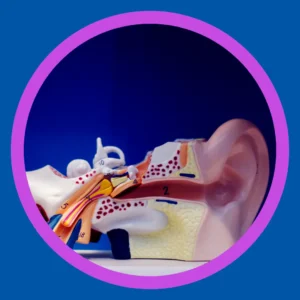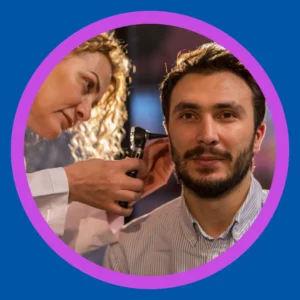Understanding Hearing Loss Types
Hearing loss affects millions of people worldwide. It is not a single condition but a range of problems that can impact how sound reaches or is processed by the brain. The three main hearing loss types are sensorineural, conductive, and mixed hearing loss. A fourth, auditory processing disorder, is different because it involves how the brain interprets sounds.
Understanding the type of hearing loss is the first step toward choosing the right solution. Different causes, symptoms, and treatments exist for each. Let’s explore each type in detail.

Sensorineural Hearing Loss (SNHL)
Sensorineural hearing loss is the most common form. It happens when the inner ear or auditory nerve is damaged. This prevents sound signals from reaching the brain clearly. Once these delicate structures are harmed, the loss is usually permanent.
Causes of SNHL
Several conditions can damage the inner ear or nerve:
- Aging (presbycusis): Gradual decline in hearing over time.
- Noise exposure: Long-term loud noise or sudden blasts.
- Medical conditions: Heart disease, diabetes, or autoimmune disorders.
- Infections: Mumps, meningitis, or viral illnesses.
- Ear growths: Acoustic neuroma or other tumors.
- Trauma: Head injuries or concussions.
- Ototoxic medications: Certain antibiotics, chemotherapy, or high doses of aspirin.
- Genetics: Syndromes passed from parents to children.
Symptoms of SNHL
People with SNHL often describe hearing but not understanding. Signs may include:
- Conversations seem mumbled.
- High-pitched sounds, like children’s voices, are unclear.
- Difficulty following group discussions.
- Trouble in noisy environments like restaurants or stadiums.
- Constant ringing or buzzing in the ears (tinnitus).
- Some sounds seem too loud, while others are too quiet.
Treatment Options
Although sensorineural loss cannot be reversed, treatment can improve quality of life:
- Hearing aids: The primary treatment for mild to moderate SNHL.
- Power hearing aids or cochlear implants: Options for severe to profound cases.
- Assistive devices: Tools like TV streamers or Bluetooth systems for clarity.
- Communication strategies: Lip reading or auditory training.
For people considering powerful technology, resources like choosing the best hearing aids for severe hearing loss can be helpful.
Conductive Hearing Loss
Conductive hearing loss occurs when sound cannot reach the inner ear. Problems in the outer or middle ear block sound from being transmitted. This type is less common than SNHL and may be temporary or permanent.
Causes of Conductive Hearing Loss
Outer ear problems
- Wax impaction.
- Narrowed ear canal (stenosis).
- Swimmer’s ear (otitis externa).
- Foreign objects lodged in the ear.
- Ear deformities such as microtia or atresia.
Middle ear problems
- Ruptured eardrum.
- Chronic fluid buildup from ear infections.
- Otosclerosis, abnormal bone growth in the middle ear.
- Growths like cholesteatoma.
- Trauma damaging the ossicles (hearing bones).
Symptoms of Conductive Loss
Because the inner ear works normally, sounds are still clear, just quieter. Symptoms can include:
- Turning up the TV volume helps.
- Ear pain or pressure.
- Drainage or odor from the ear.
- Voice sounds louder in your own head.
- Frustration during phone conversations.
Treatment Options
Some conductive loss can be corrected:
- Earwax removal or antibiotics: For blockages and infections.
- Surgery: Repairing a ruptured eardrum or abnormal growth.
- Implantable devices: Bone-anchored hearing systems.
- Hearing aids: When medical or surgical treatments do not restore full hearing.
Mixed Hearing Loss
Mixed hearing loss combines both sensorineural and conductive problems. This means the ear or nerve is damaged, and there is also a blockage or abnormality in the outer or middle ear.
Causes of Mixed Loss
- Trauma or blast injuries.
- Long-standing conductive loss combined with age-related SNHL.
- Temporary conductive issues (like earwax) added to permanent inner ear damage.
Symptoms of Mixed Loss
Symptoms combine features of both main types:
- Soft sounds are hard to hear.
- Conversations seem muffled or unclear.
- Both loudness and clarity are affected.
- Tinnitus may also be present.
Treatment Options
Treatment depends on which part is causing greater difficulty:
- Surgery or medical treatment: If the conductive part is significant.
- Hearing aids or implants: If the sensorineural component dominates.
- Combination of both: Many people need multiple solutions.
For families exploring technology, articles like rechargeable hearing aids make your life easier explain modern conveniences.
Comparison Chart: The Three Main Hearing Loss Types
| Type of Loss | Where the Problem Occurs | Main Causes | Key Symptoms | Treatment |
| Sensorineural | Inner ear or auditory nerve | Aging, noise, genetics, illness, trauma | Sounds muffled, trouble in noise, tinnitus | Hearing aids, cochlear implants, assistive devices |
| Conductive | Outer or middle ear | Wax, infections, fluid, bone growth, trauma | Sounds quieter but clear, ear pain or pressure | Medical treatment, surgery, hearing aids |
| Mixed | Combination of both | Trauma, age with conductive issues, chronic ear disease | Loudness and clarity problems combined | Combination of medical treatment and amplification |
Auditory Processing Disorder (APD)
Auditory processing disorder is not caused by ear damage. Instead, it happens when the brain has trouble interpreting sounds. People with APD have normal hearing but struggle to understand.
Symptoms of APD
- Difficulty understanding speech in noisy settings.
- Trouble following multi-step instructions.
- Problems knowing where sounds come from.
- Asking for repetition often.
- Reading or spelling challenges in children.
Causes and Risk Factors
- Early ear infections.
- Birth complications such as low birth weight.
- Head trauma or stroke.
- Aging and neurological conditions.
Treatment and Support
There is no cure, but therapies can help:
- Auditory training exercises.
- Reducing background noise.
- Using assistive listening devices.
- Classroom strategies for children.
WHO Classification of Hearing Impairment
The World Health Organization (WHO) provides a global standard for grading hearing loss severity.
| Grade of Impairment | Audiometric ISO Value (dB) | Performance | Recommendations |
| 0: No impairment | 25 dB or better | No or slight problems | None |
| 1: Slight impairment | 26–40 dB | Hears normal voice at 1m | Counseling, hearing aids may help |
| 2: Moderate impairment | 41–60 dB | Hears raised voice at 1m | Hearing aids recommended |
| 3: Severe impairment | 61–80 dB | Hears some words when shouted | Hearing aids or lip reading support |
| 4: Profound impairment | 81 dB+ | Cannot hear shouted voice | Hearing aids, lip reading, sign language often needed |
This classification helps providers recommend the right solutions worldwide.
Other Classifications of Hearing Loss
Hearing loss can also be described in other ways:
- Unilateral or bilateral: One ear or both.
- Pre-lingual or post-lingual: Before or after learning language.
- Symmetrical or asymmetrical: Equal in both ears or worse in one.
- Progressive or sudden: Gradual or rapid onset.
- Fluctuating or stable: Changes over time or remains constant.
- Congenital or acquired: Present at birth or developed later.
These descriptions help hearing care providers match treatment to individual needs.
Causes of Hearing Loss Across Life Stages
Hearing loss can occur at any age. Causes vary across life stages:
Prenatal:
- Genetic conditions.
- Infections during pregnancy.
Perinatal (at birth):
- Low oxygen levels.
- Severe jaundice.
- Low birth weight.
Childhood:
- Chronic ear infections.
- Fluid in the middle ear.
- Meningitis.
Adulthood and older age:
- Otosclerosis.
- Age-related degeneration.
- Noise exposure.
- Ototoxic medications.
More on the connection between illness and hearing can be found in 8 diseases that cause hearing loss.
Modern Technology and Hearing Loss Support
Today’s hearing aids offer features that were once unimaginable. Advanced models use AI sound processing, Bluetooth streaming, and rechargeability. These options improve communication in noisy environments and connect seamlessly with phones and TVs.
You can learn more in this article on the latest features available in hearing aids. Technology continues to evolve, helping people stay engaged in daily life.
Research Spotlight
Scientific studies continue to improve our understanding of hearing loss. For example, this research explains how hearing loss is categorized, how it affects people worldwide, and why early diagnosis matters. Families should know that advances in treatment and technology are making better outcomes possible.
What to Do If Hearing Loss Suddenly Appears
Hearing loss usually develops slowly, but in some cases, it can appear very suddenly. This is called sudden sensorineural hearing loss (SSHL). It happens when the inner ear or auditory nerve stops working properly, often within hours or days.
Recognizing Sudden Hearing Loss
You may notice:
- A sudden drop in hearing in one ear.
- Sounds seeming muffled or distorted.
- A popping sensation, like after being on an airplane.
- Ringing or buzzing in the affected ear.
- Dizziness or balance problems.
Some people wake up and notice hearing is gone in one ear. Others realize the change during a phone call when one side no longer works.
Why Acting Quickly Is Important
SSHL is considered a medical emergency. Waiting to see if it improves on its own can make the problem permanent. Quick treatment within the first two weeks greatly improves the chance of partial or full recovery. After that window, treatment may not be as effective.
Common Causes of Sudden Hearing Loss
Several conditions can trigger SSHL, including:
- Viral infections affecting the inner ear.
- Blood circulation issues in the ear.
- Autoimmune conditions.
- Head or ear trauma.
- Ototoxic drugs.
- Tumors like acoustic neuroma.
In many cases, the exact cause is unknown, which is why urgent testing is so important.
What to Do Right Away
If you or someone you know experiences sudden hearing loss:
- Seek immediate medical care. Contact a hearing care provider or ENT specialist.
- Do not ignore the symptoms. Even if only one ear is affected, treatment matters.
- Avoid loud environments. Protect your ears from additional stress until evaluated.
- Note any other symptoms. Ringing, dizziness, or pain may help guide diagnosis.
How Doctors Diagnose Sudden Hearing Loss
A provider may perform:
- Hearing tests to confirm the type and severity.
- Physical exam to rule out wax or blockages.
- Imaging scans (MRI or CT) if a tumor or neurological issue is suspected.
- Blood tests to check for infection or autoimmune activity.
Treatment Options
- Corticosteroids: Usually the first treatment, either as pills or injections into the ear.
- Antiviral or other medicines: If infection is suspected.
- Hyperbaric oxygen therapy: In some cases, this improves oxygen supply to the ear.
- Hearing aids or implants: If permanent loss remains after treatment.
When to Get Emergency Help
Go to urgent care or the emergency room if:
- Hearing loss develops in less than 72 hours.
- You also have dizziness, sudden headache, or facial weakness.
- The loss is accompanied by severe ear pain or drainage.

Take the Next Step Toward Better Hearing
If you recognize symptoms in yourself or a loved one, do not wait. Early action can improve communication and protect long-term quality of life.
At Stanford Hearing, we help patients and families understand hearing loss types and explore the best solutions. From advanced testing to personalized hearing aid fittings, we guide you through every step.
👉 Contact Stanford Hearing today to schedule your appointment and take control of your hearing health.
